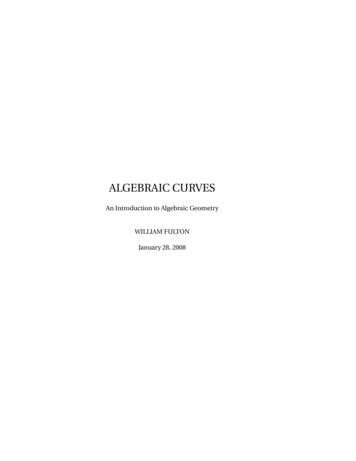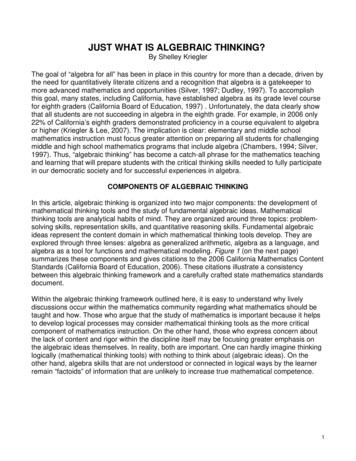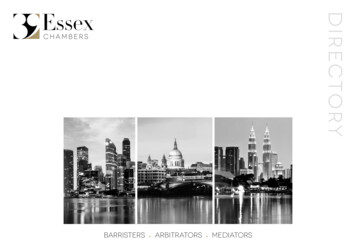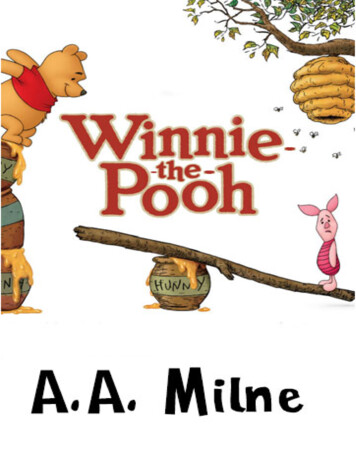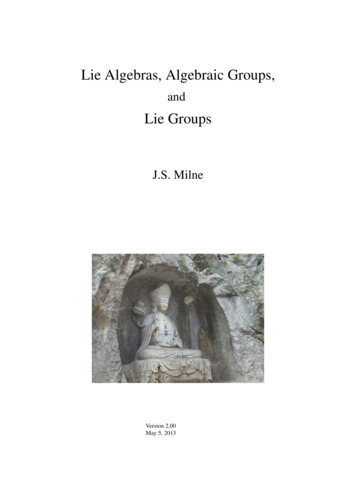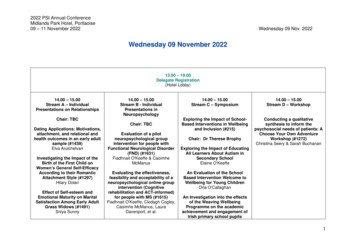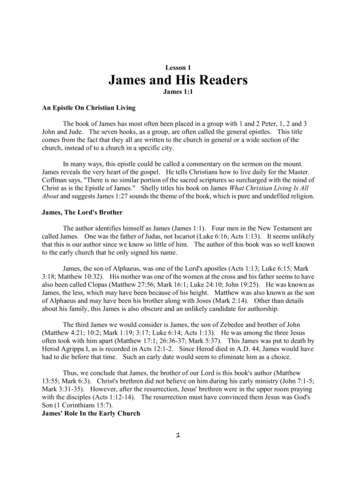
Transcription
AlgebraicNumber TheoryJ.S. MilneVersion 3.08July 19, 2020
An algebraic number field is a finite extension of Q; an algebraic number is an elementof an algebraic number field. Algebraic number theory studies the arithmetic of algebraicnumber fields — the ring of integers in the number field, the ideals and units in the ring ofintegers, the extent to which unique factorization holds, and so on.An abelian extension of a field is a Galois extension of the field with abelian Galoisgroup. Class field theory describes the abelian extensions of a number field in terms of thearithmetic of the field.These notes are concerned with algebraic number theory, and the sequel with class fieldtheory.BibTeX information@misc{milneANT,author {Milne, James S.},title {Algebraic Number Theory (v3.08)},year {2020},note {Available at www.jmilne.org/math/},pages {166}}v2.01 (August 14, 1996). First version on the web.v2.10 (August 31, 1998). Fixed many minor errors; added exercises and an index; 138 pages.v3.00 (February 11, 2008). Corrected; revisions and additions; 163 pages.v3.01 (September 28, 2008). Fixed problem with hyperlinks; 163 pages.v3.02 (April 30, 2009). Minor fixes; changed chapter and page styles; 164 pages.v3.03 (May 29, 2011). Minor fixes; 167 pages.v3.04 (April 12, 2012). Minor fixes.v3.05 (March 21, 2013). Minor fixes.v3.06 (May 28, 2014). Minor fixes; 164 pages.v3.07 (March 18, 2017). Minor fixes; 165 pages.v3.08 (July 19, 2020). Minor fixes; 166 pages.Available at www.jmilne.org/math/Please send comments and corrections to me at jmilne at umich dot edu.The photograph is of the Fork Hut, Huxley Valley, New Zealand.Copyright c 1996–2020 J.S. Milne.Single paper copies for noncommercial personal use may be made without explicit permissionfrom the copyright holder.
Contents123Notation . . . . . . . . . . . . . . . . . . . . . . . . . . . . . . . . . . . . . . .Introduction . . . . . . . . . . . . . . . . . . . . . . . . . . . . . . . . . . . . .Exercises . . . . . . . . . . . . . . . . . . . . . . . . . . . . . . . . . . . . . .4712Preliminaries from Commutative AlgebraBasic definitions . . . . . . . . . . . . . . . .Ideals in products of rings . . . . . . . . . . .Noetherian rings . . . . . . . . . . . . . . . .Noetherian modules . . . . . . . . . . . . . .Local rings . . . . . . . . . . . . . . . . . .Rings of fractions . . . . . . . . . . . . . . .The Chinese remainder theorem . . . . . . .Review of tensor products . . . . . . . . . . .Exercise . . . . . . . . . . . . . . . . . . . .14141515161718192124.Rings of IntegersFirst proof that the integral elements form a ring . . . .Dedekind’s proof that the integral elements form a ringIntegral elements . . . . . . . . . . . . . . . . . . . .Review of bases of A-modules . . . . . . . . . . . . .Review of norms and traces . . . . . . . . . . . . . . .Review of bilinear forms . . . . . . . . . . . . . . . .Discriminants . . . . . . . . . . . . . . . . . . . . . .Rings of integers are finitely generated . . . . . . . . .Finding the ring of integers . . . . . . . . . . . . . . .Algorithms for finding the ring of integers . . . . . . .Exercises . . . . . . . . . . . . . . . . . . . . . . . .252526283131323335374044Dedekind Domains; FactorizationDiscrete valuation rings . . . . . . . . . .Dedekind domains . . . . . . . . . . . .Unique factorization of ideals . . . . . . .The ideal class group . . . . . . . . . . .Discrete valuations . . . . . . . . . . . .Integral closures of Dedekind domains . .Modules over Dedekind domains (sketch).Factorization in extensions . . . . . . . .The primes that ramify . . . . . . . . . .464648495255575759601.
Finding factorizations . . .Examples of factorizationsEisenstein extensions . . .Exercises . . . . . . . . .4567.62636667The Finiteness of the Class NumberNorms of ideals . . . . . . . . . . . . . . . . . . . .Statement of the main theorem and its consequences .Lattices . . . . . . . . . . . . . . . . . . . . . . . .Some calculus . . . . . . . . . . . . . . . . . . . . .Finiteness of the class number . . . . . . . . . . . .Binary quadratic forms . . . . . . . . . . . . . . . .Exercises . . . . . . . . . . . . . . . . . . . . . . .6868707377798183The Unit TheoremStatement of the theorem . . . . . . . . . . . . .Proof that UK is finitely generated . . . . . . . .Computation of the rank . . . . . . . . . . . . .S -units . . . . . . . . . . . . . . . . . . . . . . .Example: CM fields . . . . . . . . . . . . . . . .Example: real quadratic fields . . . . . . . . . .Example: cubic fields with negative discriminantFinding .K/ . . . . . . . . . . . . . . . . . . .Finding a system of fundamental units . . . . . .Regulators . . . . . . . . . . . . . . . . . . . . .Exercises . . . . . . . . . . . . . . . . . . . . .858587889090919293939494Cyclotomic Extensions; Fermat’s Last Theorem.The basic results . . . . . . . . . . . . . . . . . . . . . .Class numbers of cyclotomic fields . . . . . . . . . . . .Units in cyclotomic fields . . . . . . . . . . . . . . . . .The first case of Fermat’s last theorem for regular primesExercises . . . . . . . . . . . . . . . . . . . . . . . . .9595101101102104Absolute Values; Local FieldsAbsolute Values . . . . . . . . . . . . . . . . . . . . . .Nonarchimedean absolute values . . . . . . . . . . . . .Equivalent absolute values . . . . . . . . . . . . . . . .Properties of discrete valuations . . . . . . . . . . . . .Complete list of absolute values for the rational numbersThe primes of a number field . . . . . . . . . . . . . . .The weak approximation theorem . . . . . . . . . . . .Completions . . . . . . . . . . . . . . . . . . . . . . . .Completions in the nonarchimedean case . . . . . . . . .Newton’s lemma . . . . . . . . . . . . . . . . . . . . .Extensions of nonarchimedean absolute values . . . . . .Newton’s polygon . . . . . . . . . . . . . . . . . . . . .Locally compact fields . . . . . . . . . . . . . . . . . .105105106107109110111113114116119123125126.
Unramified extensions of a local fieldTotally ramified extensions of K . . .Ramification groups . . . . . . . . . .Krasner’s lemma and applications . .Exercises . . . . . . . . . . . . . . .8.Global FieldsExtending absolute values . . . . . . . . . . . .The product formula . . . . . . . . . . . . . .Decomposition groups . . . . . . . . . . . . .The Frobenius element . . . . . . . . . . . . .Examples . . . . . . . . . . . . . . . . . . . .Computing Galois groups (the hard way) . . . .Computing Galois groups (the easy way) . . . .Applications of the Chebotarev density theoremFiniteness Theorems . . . . . . . . . . . . . .Exercises . . . . . . . . . . . . . . . . . . . ASolutions to the Exercises153BTwo-hour examination160Bibliography161Index163
NotationWe use the standard (Bourbaki) notation: N D f0; 1; 2; : : :g; Z D ring of integers; R D fieldof real numbers; C D field of complex numbers; Fp D Z pZ D field with p elements, p aprime number.For integers m and n, mjn means that m divides n, i.e., n 2 mZ. Throughout the notes,p is a prime number, i.e., p D 2; 3; 5; : : :.Given an equivalence relation, Œ denotes the equivalence class containing . The emptyset is denoted by ;. The cardinality of a set S is denoted by jS j (so jSj is the number ofelements in S when S is finite). Let I and A be sets; a family of elements of A indexed byI , denoted .ai /i 2I , is a function i 7! ai W I ! A.X YX is a subset of Y (not necessarily proper);defX DYX is defined to be Y , or equals Y by definition;X YX is isomorphic to Y ;X 'YX and Y are canonically isomorphic (or there is a given or unique isomorphism);,!denotes an injective map; denotes a surjective map.monnnnn question nnnnn in mathoverflow.netIt is standard to use Gothic (fraktur) letters for ideals:a b c m n p q A B Ca b c m n p q A B CM N P QM N P QPrerequisitesThe algebra usually covered in a first-year graduate course, for example, Galois theory, grouptheory, and multilinear algebra. An undergraduate number theory course will also be helpful.ReferencesIn addition to the references listed at the end and in footnotes, I shall refer to the followingof my course notes (available at www.jmilne.org/math/):FT Fields and Galois Theory, v4.61, 2020.GT Group Theory, v3.16, 2020.CFT Class Field Theory, v4.02, 2013.AcknowledgementsI thank the following for providing corrections and comments for earlier versions of thesenotes: Vincenzo Acciaro; Michael Adler; Giedrius Alkauskas; Baraksha; Omar Baratelli;Francesc Castellà; Kwangho Choiy; Dustin Clausen; Keith Conrad; Edgar Costa, SeanEberhard, Paul Federbush; Marco Antonio Flores Martı́nez; Nathan Kaplan, Nevin Guo;Georg Hein; Florian Herzig; Dieter Hink; Hau-wen Huang; Enis Kaya; Keenan Kidwell;Jianing Li; Roger Lipsett; Loy Jiabao, Jasper; Lee M. Goswick; Samir Hasan; LawrenceHowe; Lars Kindler; Franz Lemmermeyer; Milan Malčić; Siddharth Mathur; Bijan Mohebi;Yogesh More; Scott Mullane; Safak Ozden; Wai Yan Pong; Nicolás Sirolli; Sam Spiro;Thomas Stoll; Bhupendra Nath Tiwari; Vishne Uzi; and others.PARI is an open source computer algebra system freely available from http://pari.math.ubordeaux.fr/.4
D RAMATIS P ERSONÆF ERMAT (1601–1665). Stated his last “theorem”, and proved it for m D 4. He also posedthe problem of finding integer solutions to the equation,X2AY 2 D 1;A 2 Z;(1)pwhich is essentially the problem1 of finding the units in ZŒ A . Brouncker found analgorithm for solving the problem, but neglected to prove that the algorithm always works.E ULER (1707–1783). He introduced analysis into the study of the prime numbers, and hediscovered an early version of the quadratic reciprocity law.L AGRANGE (1736–1813). He proved that the algorithm for solving (1) always leads to asolution, and he proved that every positive integer is a sum of four squares. L EGENDRE (1752–1833). He introduced the “Legendre symbol” mp , and he found thecomplete form of the quadratic reciprocity law, p q .p 1/.q 1/ 4; p; q odd primes.qp D . 1/He proved a result that implies the following local-global principle for quadratic forms inthree variables over Q: such a form Q.X; Y; Z/ has a nontrivial zero in Q if and only if ithas one in R and the congruence Q 0 mod p n has a nontrivial solution for all p and n.G AUSS (1777–1855). He found the first complete proofs of the quadratic reciprocity law.He studied the Gaussian integers ZŒi in order to find a quartic reciprocity law. He studiedthe classification of binary quadratic forms over Z, which is closely related to the problemof finding the class numbers of quadratic fields.D IRICHLET (1805–1859). He introduced L-series, and used them to prove an analytic formula for the class number and a density theorem for the primes in an arithmetic progression.He proved the following “unit theorem”: let be a root of a monic irreducible polynomialf .X/ with integer coefficients; suppose that f .X / has r real roots and 2s complex roots;then ZŒ is a finitely generated group of rank r C s 1.K UMMER (1810–1893). He made a deep study of the arithmetic of cyclotomic fields,motivated by a search for higher reciprocity laws, and showed that unique factorization couldbe recovered by the introduction of “ideal numbers”. He proved that Fermat’s last theoremholds for regular primes.H ERMITE (1822–1901). He made important contributions to quadratic forms, and he showedthat the roots of a polynomial of degree 5 can be expressed in terms of elliptic functions.E ISENSTEIN (1823–1852). He published the first complete proofs for the cubic and quarticreciprocity laws.K RONECKER (1823–1891). He developed an alternative to Dedekind’s ideals. He also hadone of the most beautiful ideas in mathematics for generating abelian extensions of numberfields (the Kronecker liebster Jugendtraum).R IEMANN (1826–1866). Studied the Riemann zeta function, and made the Riemann hypothesis.D EDEKIND (1831–1916). He laid the modern foundations of algebraic number theory byfinding the correct definition of the ring of integers in a number field, by proving that ideals1 The Indianmathematician Bhaskara (12th century) knew general rules for finding solutions to the equation.
factor uniquely into products of prime ideals in such rings, and by showing that, moduloprincipal ideals, they fall into finitely many classes. Defined the zeta function of a numberfield.W EBER (1842–1913). Made important progress in class field theory and the KroneckerJugendtraum.H ENSEL (1861–1941).He gave the first definition of the field of p-adic numbers (as the setPnof infinite sums 1nD k an p , an 2 f0; 1; : : : ; p 1g).H ILBERT (1862–1943). He wrote a very influential book on algebraic number theory in1897, which gave the first systematic account of the theory. Some of his famous problemswere on number theory, and have also been influential.TAKAGI (1875–1960). He proved the fundamental theorems of abelian class field theory, asconjectured by Weber and Hilbert.N OETHER (1882–1935). Together with Artin, she laid the foundations of modern algebrain which axioms and conceptual arguments are emphasized, and she contributed to theclassification of central simple algebras over number fields.H ECKE (1887–1947). Introduced Hecke L-series generalizing both Dirichlet’s L-series andDedekind’s zeta functions.A RTIN (1898–1962). He found the “Artin reciprocity law”, which is the main theorem ofclass field theory (improvement of Takagi’s results). Introduced the Artin L-series.H ASSE (1898–1979). He gave the first proof of local class field theory, proved the Hasse(local-global) principle for all quadratic forms over number fields, and contributed to theclassification of central simple algebras over number fields.B RAUER (1901–1977). Defined the Brauer group, and contributed to the classification ofcentral simple algebras over number fields.W EIL (1906–1998). Defined the Weil group, which enabled him to give a common generalization of Artin L-series and Hecke L-series.C HEVALLEY (1909–84). The main statements of class field theory are purely algebraic,but all the earlier proofs used analysis; Chevalley gave a purely algebraic proof. With hisintroduction of idèles he was able to give a natural formulation of class field theory forinfinite abelian extensions.I WASAWA (1917–1998). He introduced an important new approach into algebraic numbertheory which was suggested by the theory of curves over finite fields.TATE (1925–2019). He proved new results in group cohomology, which allowed him togive an elegant reformulation of class field theory. With Lubin he found an explicit way ofgenerating abelian extensions of local fields.L ANGLANDS (1936– ). The Langlands program is a vast series of conjectures that, amongother things, contains a nonabelian class field theory.6
IntroductionIt is greatly to be lamented that this virtue of the[rational integers], to be decomposable into primefactors, always the same ones for a given number,does not also belong to the [integers of cyclotomicfields].Kummer 1844 (as translated by André Weil)The fundamental theorem of arithmetic says that every nonzero integer m can bewritten in the form,m D p1 pn ; pi a prime number,and that this factorization is essentially unique.Consider more generally an integral domain A. An element a 2 A is said to be a unit ifit has an inverse in A (element b such that ab D 1 D ba). I write A for the multiplicativegroup of units in A. An element of A is said to prime if it is neither zero nor a unit, and if jab H) ja or jb:If A is a principal ideal domain, then every nonzero element a of A can be written in theform,a D u 1 n ; u a unit; i a prime element;and this factorization is unique up to order and replacing each i with an associate, i.e., withits product with a unit.Our first task will be to discover to what extent unique factorization holds, or fails tohold, in number fields. Three problems present themselves. First, factorization in a fieldonly makes sense with respect to a subring, and so we must define the “ring of integers”OK in our number field K. Secondly, since unique factorization will fail in general, weshall need to find a way of measuring by how much it fails. Finally, since factorization isonly considered up to units, in order to fully understand the arithmetic of K, we need tounderstand the structure of the group of units UK in OK .The ring of integersLet K be an algebraic number field. Each element of K satisfies an equation n C a1 n1C C an D 0with coefficients a1 ; : : : ; an in Q, and is said to be an algebraic integer if it satisfies suchan equation with coefficients a1 ; : : : ; an in Z. We shall see (2.1) that the algebraic integersform a subring OK of K.7
8IntroductionAn algebraic number is an algebraic integer if and only if its minimal ppolynomial overQ has coefficients in Z (see 2.11). Consider, for example, thepfield K D QŒ d , where d isa square-free integer. The minimal polynomial of D a C b d , b 0, a; b 2 Q, ispp.X .a C b d //.X .a b d // D X 2 2aX C .a2 b 2 d /;and so is an algebraic integer if and only if2a 2 Z;a2b 2 d 2 Z:From this it follows easily that, when d 2; 3 mod 4, is an algebraic integer if and only ifa and b are integers, i.e.,noppOK D ZŒ d D a C b d j a; b 2 Z ;and, if d 1 mod 4, is an algebraic integer if and only if a and b are either both integersor both half-integers, i.e.,ˇonppˇOK D ZŒ 1C2 d D a C b 1C2 d ˇ a; b 2 Z .For example,pD ZŒ5 pOQŒp5 D ZŒ.1 C 5/ 2 :OQŒp5 ppNote that .1 C 5/ 2 satisfies X 2 X 1 D 0 and so it is an algebraic integer in QŒ 5 .Let d be a primitive d th root of 1, for example, d D exp.2 i d /, and let K D QŒ d .Then we shall see (6.2) that POK D ZŒ d Dmi di j mi 2 Z :as one would hope.FactorizationA nonzero element of an integral domain A is said to be irreducible if it is not a unit, andcannot be written as a product of two nonunits. For example, a prime element is (obviously)irreducible. A ring A is a unique factorization domain if every nonzero element of A can beexpressed as a product of irreducible elements in essentially one way. Is the ring of integersOK a unique factorization domain? No, not in general!We shall see that each element of OK can be written as a product of irreducible elements(this is true for all noetherianrings), and so it is the uniqueness that fails.pFor example, in ZŒ5 we havepp5/.15/:6 D 2 3 D .1 CppTo see that 2, 3, 1 C5, 15 are irreducible, and no two are associates, we use thenorm mapppNmW QŒ5 ! Q; a C b5 7! a2 C 5b 2 :
9This is multiplicative, and it is easy to see that, for 2 OK ,Nm. / D 1 ” N D 1 ” is a unit.(2)pIf 1 C5 D ˇ, then Nm. ˇ/ D Nm.1 C5/ D 6. Thus Nm. / D 1; 2; 3, or 6. In thefirst case, is a unit, the second and third cases don’tp occur, and in the fourth case ˇ is aunit. A similar argument shows that 2; 3, and 15 are irreducible. Next notep that (2)implies5 andp that associates have the same norm, and so it remains to show that 1 C15 are not associates, butppp1C5 D .a C b5/.15/phas no solution with a; b 2 Z.Why does unique factorization fail in OK ? Thepproblem is that irreducible elements inOK need not be prime. In the above example, 1 C5 divides 2 3 but it divides neither 2nor 3. In fact, in an integral domain in which factorizations exist (e.g. a noetherian ring),factorization is unique if all irreducible elements are prime.What can we recover? Consider210 D 6 35 D 10 21:If we were naive, we might say this shows factorization is not unique in Z; instead, werecognize that there is a unique factorization underlying these two decompositions, namely,210 D .2 3/.5 7/ D .2 5/.3 7/:The idea of Kummerand Dedekind was to enlarge the set of “prime numbers” so that, forpexample, in ZŒ5 there is a unique factorization,6 D .p21 /.p2 p3 / D .p1 p2 /.p1 p3 /;underlying the above factorization; here the pi are “ideal prime factors”.How do we define “ideal factors”? Clearly, an ideal factor should be characterized by thealgebraic integers it divides. Moreover divisibility by a should have the following properties:aj0Iaja; ajb ) aja bIaja ) ajab for all b 2 OK :If in addition division by a has the property thatajab ) aja or ajb;then we call a a “prime ideal factor”. Since all we know about an ideal factor is the set ofelements it divides, we may as well identify it with this set. Thus an ideal factor a is a set ofelements of OK such that0 2 aIa; b 2 a ) a b 2 aIa 2 a ) ab 2 a for all b 2 OK Iit is prime if an addition,ab 2 a ) a 2 a or b 2 a:Many of you will recognize that an ideal factor is what we now call an ideal, and a primeideal factor is a prime ideal.
10IntroductionThere is an obvious notion of the product of two ideals:Xabjc ” c Dai bi ; ajai ; bjbi :iIn other words,ab DnXiobi 2 b :ai bi j ai 2 a;One sees easily that this is again an ideal, and that if a D .a1 ; :::; am / and b D .b1 ; :::; bn /,thena b D .a1 b1 ; :::; ai bj ; :::; am bn /:With these definitions, one recovers unique factorization: if a 0, then there is anessentially unique factorization,.a/ D p1 pn with each pi a prime ideal.In the above example,.6/ D .2; 1 Cp5/2 .3; 1 Cp5/.3; 1p5/:In fact, I claim.3; 1 C.2; 1 C.2; 1 Cppp.2; 1 Cp5/.3; 15/.3; 1 C5/.3; 1ppp5/2 D .2/5/ D .3/5/ D .1 C5/ D .1pp5/5/:pppFor example, .2; 1 C5/.2; 1 C5/ D .4; 2 C 25; 6/. Since every generator isdivisible by 2, we see thatpp5/.2; 1 C5/ .2/:.2; 1 CConversely,2D64 2 .4; 2 C 2p5; 6/pand so .2; 1 C p 5/2 D .2/, as claimed.I further claim that the three ideals .2; 1 Cpp5/, p.3; 1 C5/,pand .3; 15/ are all prime. For example, the obvious mapZ ! ZŒ5 .3; 15/ is surjective with kernel .3/, and soppZŒ5 .3; 15/ ' Z .3/;which is an integral domain.How far is this from what we want, namely, unique factorization of elements? In otherwords, how many “ideal” elements have we had to add to our “real” elements to get uniquefactorization. In a certain sense, only a finite number: we shall see that there exists a finiteset S of ideals such that every ideal is of the form a .a/ for some a 2 S and some a 2 OK .Better, we shall construct a group I of “fractional” ideals in which the principal fractionalideals .a/, a 2 K , form a subgroup P of finite index. The index .I W P / is called the classnumber hK of K. We shall see thathK D 1 ” OK is a principal ideal domain ” OK has unique factorization.
11A theorem of Carlitz says that, if hK 1, then hK D 2 ” the length of a factorization ofan arbitrary integer of K does not dependpon the factorization.25 is 2. The idealsFor example, the class number of QŒpppp.3; 1 C5/; .3; 15/; .7; 3 C5/; .7; 35/pin ZŒ5 are prime and not principal, and so each represents the nontrivial element inI P . Therefore, the productp of any two of them is principal. Using this we get three distinctfactorizations of 21 in ZŒ5 ,pppp21 D 3 7 D .4 C5/ .45/ D .1 C 25/ .1 25/;all of length 2.UnitsUnlike Z, the ring pOK can have infinitely many units. For example, .1 Cinfinite order in ZŒ 2 ,ppp.1 C 2/. 1 C 2/ D 1I .1 C 2/m 1 if m 0:ppIn fact ZŒ 2 D f .1 C 2/m j m 2 Zg, and sopZŒ 2 f 1g ffree abelian group of rank 1g:p2/ is a unit ofIn general, we shall show (unit theorem) that the roots of 1 in K form a finite group .K/,and that OK .K/ Zr (as an abelian group);moreover, we shall find r:ApplicationsOne motivation for the development of algebraic number theory was the attempt to proveFermat’s last “theorem”, i.e., when m 3, there are no integer solutions .x; y; z/ to theequationX m C Y m D Zmwith all of x; y; z nonzero.When m D 3, this can be proved by the method of “infinite descent”, i.e., from onesolution, you show that you can construct a smaller solution, which leads to a contradiction.3The proof makes use of the factorizationY 3 D Z3X 3 D .ZX /.Z 2 C XZ C X 2 /;and it was recognized that a stumbling block to proving the theorem for larger m is that nosuch factorization exists into polynomials with integer coefficients of degree 2. This ledpeople to look at more general factorizations.2 Chapman,Scott T. So what is class number 2? Amer. Math. Monthly 126 (2019), no. 4, 330–339.used infinite descent to show that every integer 1 has a prime factorization, and the usual proof2 is irrational is by infinite descent.3 Euclidthatp
12IntroductionIn a famous incident, the French mathematician Lamé gave a talk at the Paris Academyin 1847 in which he claimed to prove Fermat’s last theorem using the following ideas. Letp 2 be a prime, and suppose that x, y, z are nonzero integers such thatxp C yp D zp :Writexp D zpyp DY.z i y/;0 i p1; D e 2 i p :He then showed how to obtain a smaller solution to the equation, and hence a contradiction.Liouville immediately questioned a step in Lamé’s proof in which he assumed that, in orderto show that each factor .z i y/ is a pth power, it suffices to show that the factors arerelatively prime in pairs and their product is a pth power. In fact, Lamé couldn’t justify hisstep (ZŒ is not always a principal ideal domain), and Fermat’s last theorem was not provedfor almost 150 years. However, shortly after Lamé’s embarrassing lecture, Kummer usedhis results on the arithmetic of the fields QŒ to prove Fermat’s last theorem for all regularprimes, i.e., for all primes p such that p does not divide the class number of QŒ p .Another application is to finding Galois groups. The splitting field of a polynomialf .X/ 2 QŒX is a Galois extension of Q. In a basic Galois theory course, we learn how tocompute the Galois group only when the degree is very small. By using algebraic numbertheory one can write down an algorithm to do it for any degree.For applications of algebraic number theory to elliptic curves, see Milne 2020.Some comments on the literatureC OMPUTATIONAL NUMBER THEORYCohen 1993 and Pohst and Zassenhaus 1989 provide algorithms for most of the constructionswe make in this course. The first assumes the reader knows number theory, whereas thesecond develops the whole subject algorithmically. Cohen’s book is the more useful as asupplement to this course, but wasn’t available when these notes were first written. Whilethe books are concerned with more-or-less practical algorithms for fields of small degreeand small discriminant, Lenstra (1992) concentrates on finding “good” general algorithms.H ISTORY OF ALGEBRAIC NUMBER THEORYDedekind 1996, with its introduction by Stillwell, gives an excellent idea of how algebraicnumber theory developed. Edwards 1977 is a history of algebraic number theory, concentrating on the efforts to prove Fermat’s last theorem. The notes in Narkiewicz 1990 documentthe origins of most significant results in algebraic number theory. Lemmermeyer 2009explains the origins of “ideal numbers”; see also the other writings by the same author, e.g.,Lemmermeyer 2000, 2007.Exercises0-1p Let d be a square-free integer. Complete the verification that the ring of integers inQŒ d is as described.
Exercisesp0-2 Complete the verification that, in ZŒ5 ,pp5/2 .3; 1 C5/.3; 1.6/ D .2; 1 Cis a factorization of .6/ into a product of prime ideals.13p5/
C HAPTERPreliminaries from CommutativeAlgebraMany results that were first proved for rings of integers in number fields are true for moregeneral commutative rings, and it is more natural to prove them in that context.1Basic definitionsAll rings will be commutative, and have an identity element (i.e., an element 1 such that1a D a for all a 2 A), and a homomorphism of rings will map the identity element to theidentity element.A ring B together with a homomorphism of rings A ! B will be referred to as anA-algebra. We use this terminology mainly when A is a subring of B. In this case, forelements ˇ1 ; :::; ˇm of B, we let AŒˇ1 ; :::; ˇm denote the smallest subring of B containingA and the ˇi . It consists of all polynomials in the ˇi with coefficients in A, i.e., elements ofthe formXimai1 :::im ˇ1i1 :::ˇm; ai1 :::im 2 A:We also refer to AŒˇ1 ; :::; ˇm as the A-subalgebra of B generated by the ˇi , and whenB D AŒˇ1 ; :::; ˇm we say that the ˇi generate B as an A-algebra.For elements a1 ; a2 ; : : : ofPA, we let .a1 ; a2 ; : : :/ denote the smallest ideal containing theai . It consists of finite sums ci ai , ci 2 A, and it is called the ideal generated by a1 ; a2 ; : : :.When a and b are ideals in A, we definea C b D fa C b j a 2 a, b 2 bg:It is again an ideal in A — in fact, it is the smallest ideal containing both a and b. Ifa D .a1 ; :::; am / and b D .b1 ; :::; bn /, the
He wrote a very influential book on algebraic number theory in 1897, which gave the first systematic account of the theory. Some of his famous problems were on number theory, and have also been influential. TAKAGI (1875-1960). He proved the fundamental theorems of abelian class field theory, as conjectured by Weber and Hilbert. NOETHER .
